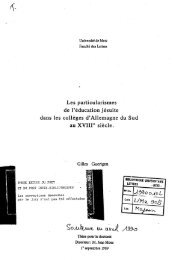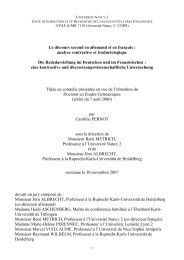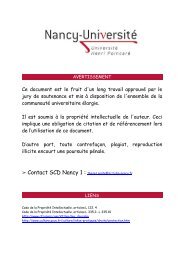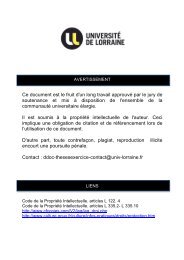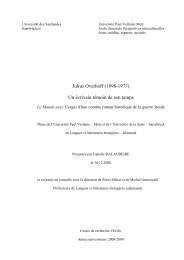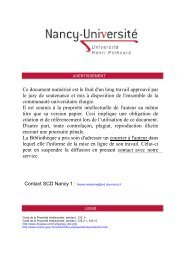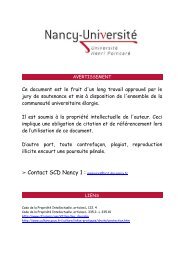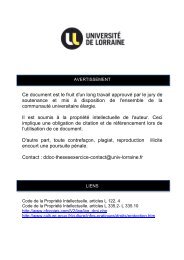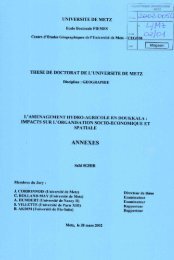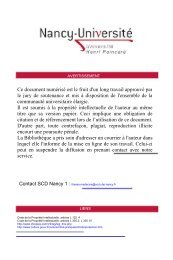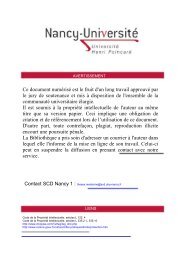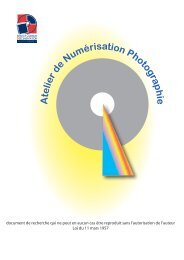Mécanismes d'évolution de texture au cours du recuit d'alliages de ...
Mécanismes d'évolution de texture au cours du recuit d'alliages de ...
Mécanismes d'évolution de texture au cours du recuit d'alliages de ...
You also want an ePaper? Increase the reach of your titles
YUMPU automatically turns print PDFs into web optimized ePapers that Google loves.
Chapitre 3: Évolution <strong>de</strong> <strong>texture</strong> globale <strong>du</strong> Zr702<br />
Laminage simple<br />
Laminage croisé<br />
Laminage transverse<br />
État déformé État recristallisé Croissance <strong>de</strong> grains<br />
Indice <strong>de</strong> <strong>texture</strong>: 4,1<br />
Max: 9,5<br />
(175 25 5)<br />
Indice <strong>de</strong> <strong>texture</strong>: 6,0<br />
Max: 14,4<br />
(345 20 5)<br />
Indice <strong>de</strong> <strong>texture</strong>: 6,2<br />
Max: 16,2<br />
(355 20 35)<br />
Indice <strong>de</strong> <strong>texture</strong>: 2,9<br />
Max: 6,7<br />
(5 35 35)<br />
Indice <strong>de</strong> <strong>texture</strong>: 3,7<br />
Max: 8,38<br />
(180 25 0)<br />
Indice <strong>de</strong> <strong>texture</strong>: 3,9<br />
Max: 8,5<br />
(355 25 0)<br />
Indice <strong>de</strong> <strong>texture</strong>: 4,0<br />
Max: 9,37<br />
(0 35 30)<br />
Indice <strong>de</strong> <strong>texture</strong>: 4,5<br />
Max: 9,06<br />
(0 0 15)<br />
Indice <strong>de</strong> <strong>texture</strong>: 6,4<br />
Max: 17,67<br />
(155 5 30)<br />
Figure 3-7: Évolution <strong>de</strong> <strong>texture</strong> <strong>au</strong> <strong>cours</strong> <strong>du</strong> <strong>recuit</strong> <strong>de</strong>s matéri<strong>au</strong>x laminés à 60% <strong>de</strong> ré<strong>du</strong>ction<br />
d'épaisseur (coupes en φ1=0° <strong>de</strong> l'espace <strong>de</strong>s orientations, nive<strong>au</strong>x tels que définis en début <strong>de</strong><br />
chapitre).<br />
2.a.3 80% <strong>de</strong> ré<strong>du</strong>ction<br />
Les évolutions <strong>de</strong> <strong>texture</strong> <strong>au</strong> <strong>cours</strong> <strong>du</strong> <strong>recuit</strong> après 80% <strong>de</strong> t<strong>au</strong>x <strong>de</strong> ré<strong>du</strong>ction sont<br />
présentées dans la figure 3-8. Globalement, on observe un affaiblissement <strong>de</strong>s <strong>texture</strong>s <strong>au</strong><br />
<strong>cours</strong> <strong>de</strong> la recristallisation, mais celles ci changent relativement peu dans le cas <strong>du</strong><br />
laminage simple et croisé. Pour ces <strong>de</strong>ux cas, les positions <strong>de</strong>s maxima sont maintenues,<br />
et dans le cas <strong>du</strong> laminage simple la composante {φ1=0°, Φ=90°, φ2=0°}, disparaît. C'est<br />
<strong>au</strong> <strong>cours</strong> <strong>de</strong> la croissance <strong>de</strong> grains que la réorientation survient. Dans le cas <strong>du</strong> laminage<br />
simple, cette réorientation consiste en une rotation <strong>de</strong> 30° relatée dans la thèse <strong>de</strong><br />
64<br />
Constant Phi1 = 0<br />
Constant Phi1 = 0 Constant Phi1 = 0<br />
Constant Phi1 = 0 Constant Phi1 = 0 Constant Phi1 = 0<br />
Constant Phi1 = 0 Constant Phi1 = 0<br />
Constant Phi1 = 0



